Advantages and Disadvantages of Social Democratic Welfare States
VerifiedAdded on 2021/04/17
|7
|1902
|237
AI Summary
The assignment discusses the characteristics of social democratic welfare states, highlighting their benefits such as education and healthcare systems, but also criticizing their high tax structures and lack of long-term goals. The document references various studies and research papers to support its arguments.
Contribute Materials
Your contribution can guide someone’s learning journey. Share your
documents today.
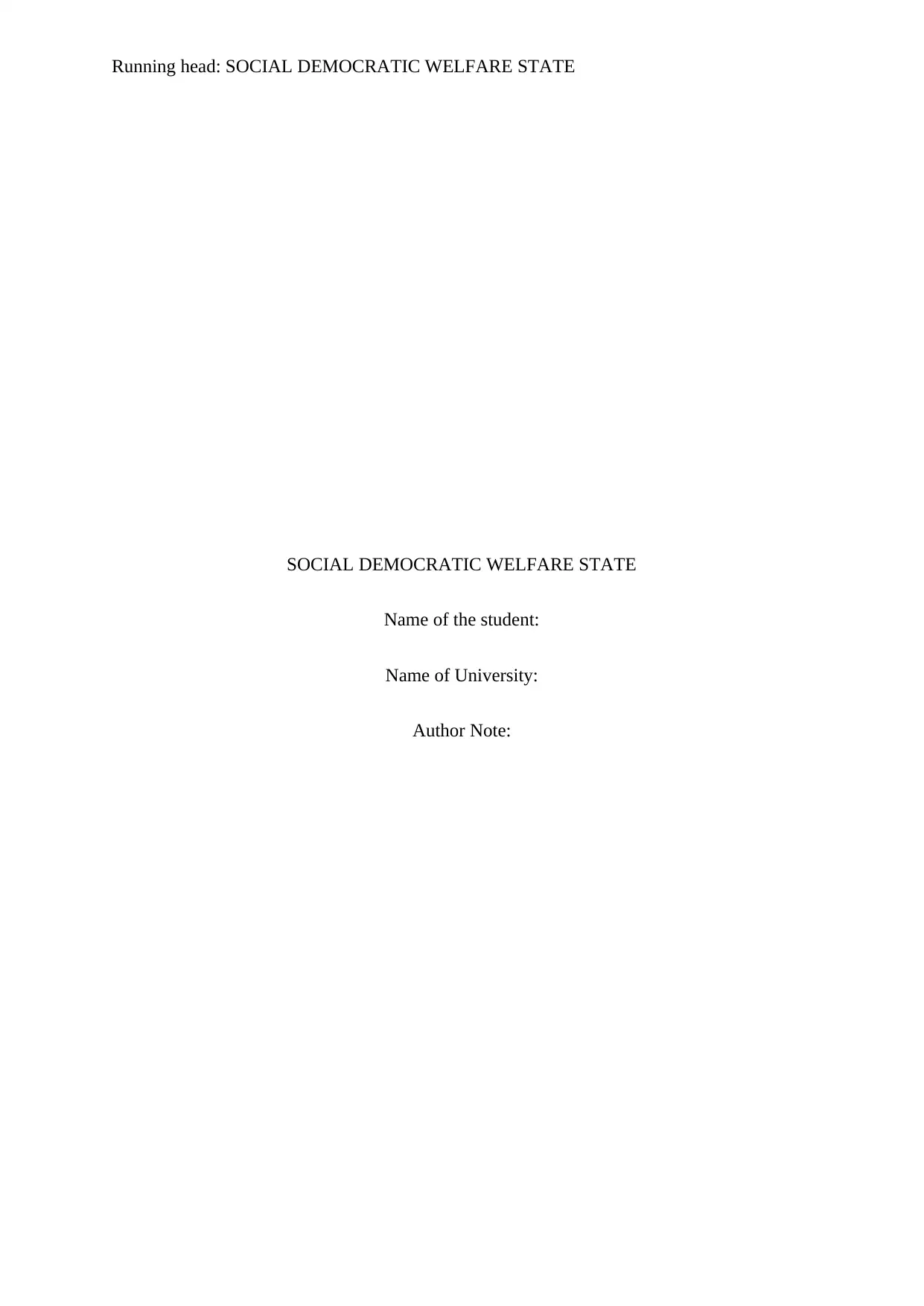
Running head: SOCIAL DEMOCRATIC WELFARE STATE
SOCIAL DEMOCRATIC WELFARE STATE
Name of the student:
Name of University:
Author Note:
SOCIAL DEMOCRATIC WELFARE STATE
Name of the student:
Name of University:
Author Note:
Secure Best Marks with AI Grader
Need help grading? Try our AI Grader for instant feedback on your assignments.
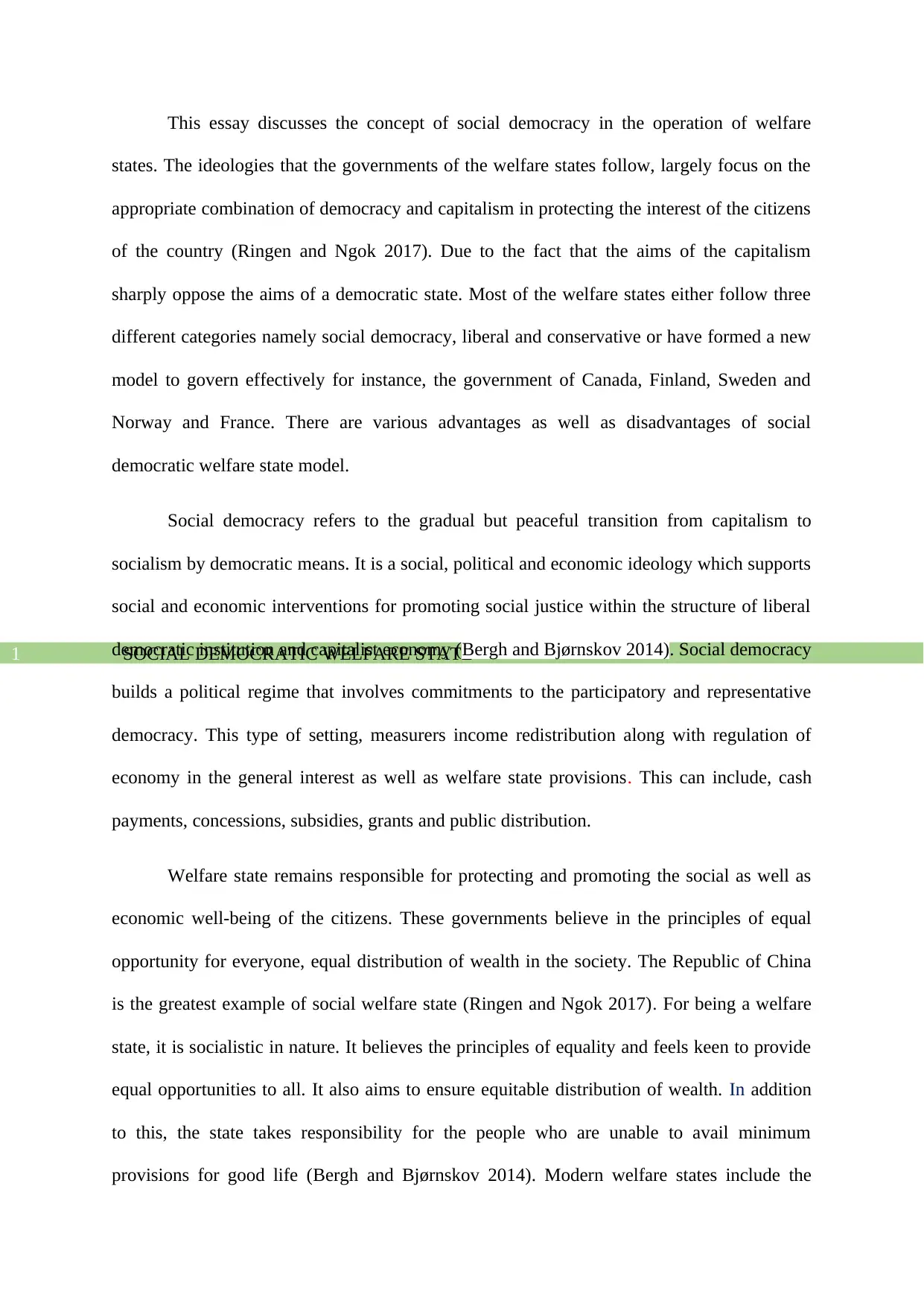
SOCIAL DEMOCRATIC WELFARE STATE1
This essay discusses the concept of social democracy in the operation of welfare
states. The ideologies that the governments of the welfare states follow, largely focus on the
appropriate combination of democracy and capitalism in protecting the interest of the citizens
of the country (Ringen and Ngok 2017). Due to the fact that the aims of the capitalism
sharply oppose the aims of a democratic state. Most of the welfare states either follow three
different categories namely social democracy, liberal and conservative or have formed a new
model to govern effectively for instance, the government of Canada, Finland, Sweden and
Norway and France. There are various advantages as well as disadvantages of social
democratic welfare state model.
Social democracy refers to the gradual but peaceful transition from capitalism to
socialism by democratic means. It is a social, political and economic ideology which supports
social and economic interventions for promoting social justice within the structure of liberal
democratic institution and capitalist economy (Bergh and Bjørnskov 2014). Social democracy
builds a political regime that involves commitments to the participatory and representative
democracy. This type of setting, measurers income redistribution along with regulation of
economy in the general interest as well as welfare state provisions. This can include, cash
payments, concessions, subsidies, grants and public distribution.
Welfare state remains responsible for protecting and promoting the social as well as
economic well-being of the citizens. These governments believe in the principles of equal
opportunity for everyone, equal distribution of wealth in the society. The Republic of China
is the greatest example of social welfare state (Ringen and Ngok 2017). For being a welfare
state, it is socialistic in nature. It believes the principles of equality and feels keen to provide
equal opportunities to all. It also aims to ensure equitable distribution of wealth. In addition
to this, the state takes responsibility for the people who are unable to avail minimum
provisions for good life (Bergh and Bjørnskov 2014). Modern welfare states include the
This essay discusses the concept of social democracy in the operation of welfare
states. The ideologies that the governments of the welfare states follow, largely focus on the
appropriate combination of democracy and capitalism in protecting the interest of the citizens
of the country (Ringen and Ngok 2017). Due to the fact that the aims of the capitalism
sharply oppose the aims of a democratic state. Most of the welfare states either follow three
different categories namely social democracy, liberal and conservative or have formed a new
model to govern effectively for instance, the government of Canada, Finland, Sweden and
Norway and France. There are various advantages as well as disadvantages of social
democratic welfare state model.
Social democracy refers to the gradual but peaceful transition from capitalism to
socialism by democratic means. It is a social, political and economic ideology which supports
social and economic interventions for promoting social justice within the structure of liberal
democratic institution and capitalist economy (Bergh and Bjørnskov 2014). Social democracy
builds a political regime that involves commitments to the participatory and representative
democracy. This type of setting, measurers income redistribution along with regulation of
economy in the general interest as well as welfare state provisions. This can include, cash
payments, concessions, subsidies, grants and public distribution.
Welfare state remains responsible for protecting and promoting the social as well as
economic well-being of the citizens. These governments believe in the principles of equal
opportunity for everyone, equal distribution of wealth in the society. The Republic of China
is the greatest example of social welfare state (Ringen and Ngok 2017). For being a welfare
state, it is socialistic in nature. It believes the principles of equality and feels keen to provide
equal opportunities to all. It also aims to ensure equitable distribution of wealth. In addition
to this, the state takes responsibility for the people who are unable to avail minimum
provisions for good life (Bergh and Bjørnskov 2014). Modern welfare states include the
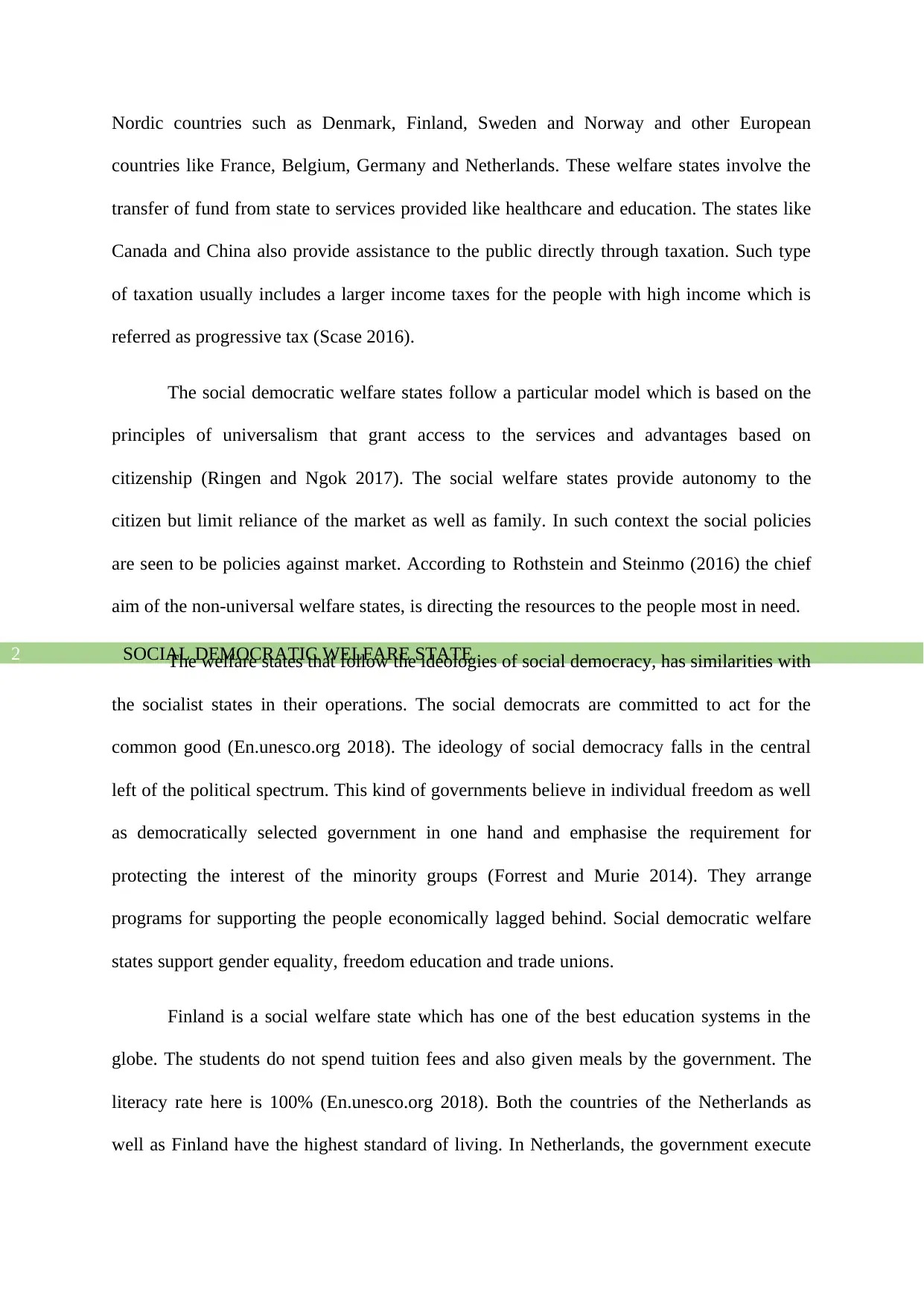
SOCIAL DEMOCRATIC WELFARE STATE2
Nordic countries such as Denmark, Finland, Sweden and Norway and other European
countries like France, Belgium, Germany and Netherlands. These welfare states involve the
transfer of fund from state to services provided like healthcare and education. The states like
Canada and China also provide assistance to the public directly through taxation. Such type
of taxation usually includes a larger income taxes for the people with high income which is
referred as progressive tax (Scase 2016).
The social democratic welfare states follow a particular model which is based on the
principles of universalism that grant access to the services and advantages based on
citizenship (Ringen and Ngok 2017). The social welfare states provide autonomy to the
citizen but limit reliance of the market as well as family. In such context the social policies
are seen to be policies against market. According to Rothstein and Steinmo (2016) the chief
aim of the non-universal welfare states, is directing the resources to the people most in need.
The welfare states that follow the ideologies of social democracy, has similarities with
the socialist states in their operations. The social democrats are committed to act for the
common good (En.unesco.org 2018). The ideology of social democracy falls in the central
left of the political spectrum. This kind of governments believe in individual freedom as well
as democratically selected government in one hand and emphasise the requirement for
protecting the interest of the minority groups (Forrest and Murie 2014). They arrange
programs for supporting the people economically lagged behind. Social democratic welfare
states support gender equality, freedom education and trade unions.
Finland is a social welfare state which has one of the best education systems in the
globe. The students do not spend tuition fees and also given meals by the government. The
literacy rate here is 100% (En.unesco.org 2018). Both the countries of the Netherlands as
well as Finland have the highest standard of living. In Netherlands, the government execute
Nordic countries such as Denmark, Finland, Sweden and Norway and other European
countries like France, Belgium, Germany and Netherlands. These welfare states involve the
transfer of fund from state to services provided like healthcare and education. The states like
Canada and China also provide assistance to the public directly through taxation. Such type
of taxation usually includes a larger income taxes for the people with high income which is
referred as progressive tax (Scase 2016).
The social democratic welfare states follow a particular model which is based on the
principles of universalism that grant access to the services and advantages based on
citizenship (Ringen and Ngok 2017). The social welfare states provide autonomy to the
citizen but limit reliance of the market as well as family. In such context the social policies
are seen to be policies against market. According to Rothstein and Steinmo (2016) the chief
aim of the non-universal welfare states, is directing the resources to the people most in need.
The welfare states that follow the ideologies of social democracy, has similarities with
the socialist states in their operations. The social democrats are committed to act for the
common good (En.unesco.org 2018). The ideology of social democracy falls in the central
left of the political spectrum. This kind of governments believe in individual freedom as well
as democratically selected government in one hand and emphasise the requirement for
protecting the interest of the minority groups (Forrest and Murie 2014). They arrange
programs for supporting the people economically lagged behind. Social democratic welfare
states support gender equality, freedom education and trade unions.
Finland is a social welfare state which has one of the best education systems in the
globe. The students do not spend tuition fees and also given meals by the government. The
literacy rate here is 100% (En.unesco.org 2018). Both the countries of the Netherlands as
well as Finland have the highest standard of living. In Netherlands, the government execute

SOCIAL DEMOCRATIC WELFARE STATE3
less control over the country’s economy, but follows socialist welfare system. The lifestyle of
the people in these states is very egalitarian yet organized, where even the higher authorities
of any organisation do not treat subordinates rudely (Taylor-Gooby, Leruth and Chung 2017).
Social democratic welfare states like Canada and Denmark take special care for the
minority groups (En.unesco.org 2018). They monitor economy by regulating market. This
guarantees full employment and proper distribution of wealth thus reduce inequality in the
society (Raphael 2014). The minority communities in any region tend to be the easiest target
of exclusion., discrimination even violence. People’s Republic of China builds provisions for
all kinds of minority groups diversified by ethnicity, wealth, language and religion
(Coppieters, Deschouwer and Waller 2014). It takes measure to prevent the inequalities and
provide opportunities for equal access to all the state provided facilities.
Subsidised education system is one of the major characteristics of the social
democratic welfare states which draws a distinct line between the welfare states and other
government systems (Ringen 2017). In the countries like Sweden, France, Canada, the
government aim to provide education to all the students irrespective of social and economic
class (Hesmondhalgh et al. 2015). Moreover, these governments play an active role in
providing systematic incentives to the universities and colleges so that they can spend money
in the scholarships and raise tuitions. Here the aim is again to help the poor but meritorious
students to excel. It is greatly followed by both China and the Netherlands (En.unesco.org
2018).
The chief activities of the welfare states aim to strengthen the disadvantaged classes
and promote equality in the society (Rueschemeyer and Skocpol 2017). However, many
critics have found out that these provisions and facilities make people more dependent on the
state. This may create a large number of less motivated labours who are habituated to receive
less control over the country’s economy, but follows socialist welfare system. The lifestyle of
the people in these states is very egalitarian yet organized, where even the higher authorities
of any organisation do not treat subordinates rudely (Taylor-Gooby, Leruth and Chung 2017).
Social democratic welfare states like Canada and Denmark take special care for the
minority groups (En.unesco.org 2018). They monitor economy by regulating market. This
guarantees full employment and proper distribution of wealth thus reduce inequality in the
society (Raphael 2014). The minority communities in any region tend to be the easiest target
of exclusion., discrimination even violence. People’s Republic of China builds provisions for
all kinds of minority groups diversified by ethnicity, wealth, language and religion
(Coppieters, Deschouwer and Waller 2014). It takes measure to prevent the inequalities and
provide opportunities for equal access to all the state provided facilities.
Subsidised education system is one of the major characteristics of the social
democratic welfare states which draws a distinct line between the welfare states and other
government systems (Ringen 2017). In the countries like Sweden, France, Canada, the
government aim to provide education to all the students irrespective of social and economic
class (Hesmondhalgh et al. 2015). Moreover, these governments play an active role in
providing systematic incentives to the universities and colleges so that they can spend money
in the scholarships and raise tuitions. Here the aim is again to help the poor but meritorious
students to excel. It is greatly followed by both China and the Netherlands (En.unesco.org
2018).
The chief activities of the welfare states aim to strengthen the disadvantaged classes
and promote equality in the society (Rueschemeyer and Skocpol 2017). However, many
critics have found out that these provisions and facilities make people more dependent on the
state. This may create a large number of less motivated labours who are habituated to receive
Secure Best Marks with AI Grader
Need help grading? Try our AI Grader for instant feedback on your assignments.

SOCIAL DEMOCRATIC WELFARE STATE4
financial and all other supports from the government without having any contribution to the
progress of the state. These people tend to prolong the processes as long as possible that
reduces their skills. Belgium is a social democratic state which provides all kinds of social
security benefits that other social democratic countries offer, including old age and invalid
pensions (En.unesco.org 2018). However, in order to provide these essential needs to the
citizens, the government controls businesses, hospitals and schools. For running these
institutions, the welfare states need a large amount of money which is generally collected
from the people as tax (Taylor-Gooby, Leruth and Chung 2017). This is the reason the
income tax rate of Finland, Netherlands, France and other welfare states is higher than that of
the other types of government systems. Moreover, in the social democratic states, their
government changes within four to six years hence one government changes the rules and
polices applied by the other (Rod et al. 2015). Ireland has one of the best welfare systems,
where the issue of unemployment is higher than Denmark or Switzerland’s. more than 20%
of GDP goes to manage the welfare system by Ireland government whereas as America’s
social support programs need only 15% (En.unesco.org 2018). This is the reason why this
type of states does not have plan long term goals hence the development gets disturbed.
Therefore, it can be concluded that there are different advantages as well as
disadvantages in the social democratic welfare states. It provides all types of benefits to its
citizens such as education, health care system and arranges various allowance systems for the
wellbeing of the citizens. On the contrary these services are being initiated through the taxes
given by the citizens. Hence the tax structure of these countries are quite high in compared to
the other nations in the world. Therefore, it can be said that people of these countries are less
competitive yet lead high quality lifestyle.
financial and all other supports from the government without having any contribution to the
progress of the state. These people tend to prolong the processes as long as possible that
reduces their skills. Belgium is a social democratic state which provides all kinds of social
security benefits that other social democratic countries offer, including old age and invalid
pensions (En.unesco.org 2018). However, in order to provide these essential needs to the
citizens, the government controls businesses, hospitals and schools. For running these
institutions, the welfare states need a large amount of money which is generally collected
from the people as tax (Taylor-Gooby, Leruth and Chung 2017). This is the reason the
income tax rate of Finland, Netherlands, France and other welfare states is higher than that of
the other types of government systems. Moreover, in the social democratic states, their
government changes within four to six years hence one government changes the rules and
polices applied by the other (Rod et al. 2015). Ireland has one of the best welfare systems,
where the issue of unemployment is higher than Denmark or Switzerland’s. more than 20%
of GDP goes to manage the welfare system by Ireland government whereas as America’s
social support programs need only 15% (En.unesco.org 2018). This is the reason why this
type of states does not have plan long term goals hence the development gets disturbed.
Therefore, it can be concluded that there are different advantages as well as
disadvantages in the social democratic welfare states. It provides all types of benefits to its
citizens such as education, health care system and arranges various allowance systems for the
wellbeing of the citizens. On the contrary these services are being initiated through the taxes
given by the citizens. Hence the tax structure of these countries are quite high in compared to
the other nations in the world. Therefore, it can be said that people of these countries are less
competitive yet lead high quality lifestyle.
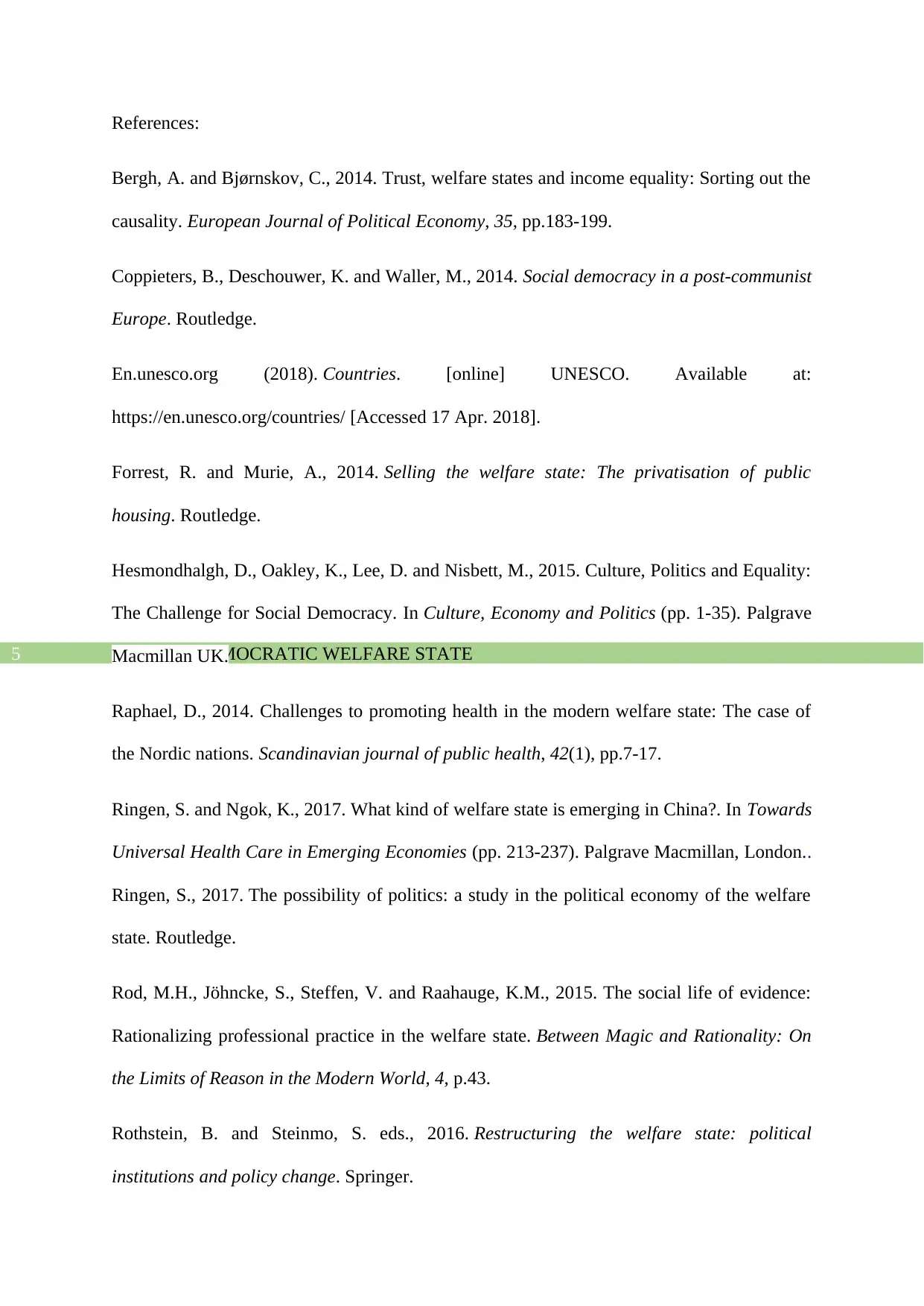
SOCIAL DEMOCRATIC WELFARE STATE5
References:
Bergh, A. and Bjørnskov, C., 2014. Trust, welfare states and income equality: Sorting out the
causality. European Journal of Political Economy, 35, pp.183-199.
Coppieters, B., Deschouwer, K. and Waller, M., 2014. Social democracy in a post-communist
Europe. Routledge.
En.unesco.org (2018). Countries. [online] UNESCO. Available at:
https://en.unesco.org/countries/ [Accessed 17 Apr. 2018].
Forrest, R. and Murie, A., 2014. Selling the welfare state: The privatisation of public
housing. Routledge.
Hesmondhalgh, D., Oakley, K., Lee, D. and Nisbett, M., 2015. Culture, Politics and Equality:
The Challenge for Social Democracy. In Culture, Economy and Politics (pp. 1-35). Palgrave
Macmillan UK.
Raphael, D., 2014. Challenges to promoting health in the modern welfare state: The case of
the Nordic nations. Scandinavian journal of public health, 42(1), pp.7-17.
Ringen, S. and Ngok, K., 2017. What kind of welfare state is emerging in China?. In Towards
Universal Health Care in Emerging Economies (pp. 213-237). Palgrave Macmillan, London..
Ringen, S., 2017. The possibility of politics: a study in the political economy of the welfare
state. Routledge.
Rod, M.H., Jöhncke, S., Steffen, V. and Raahauge, K.M., 2015. The social life of evidence:
Rationalizing professional practice in the welfare state. Between Magic and Rationality: On
the Limits of Reason in the Modern World, 4, p.43.
Rothstein, B. and Steinmo, S. eds., 2016. Restructuring the welfare state: political
institutions and policy change. Springer.
References:
Bergh, A. and Bjørnskov, C., 2014. Trust, welfare states and income equality: Sorting out the
causality. European Journal of Political Economy, 35, pp.183-199.
Coppieters, B., Deschouwer, K. and Waller, M., 2014. Social democracy in a post-communist
Europe. Routledge.
En.unesco.org (2018). Countries. [online] UNESCO. Available at:
https://en.unesco.org/countries/ [Accessed 17 Apr. 2018].
Forrest, R. and Murie, A., 2014. Selling the welfare state: The privatisation of public
housing. Routledge.
Hesmondhalgh, D., Oakley, K., Lee, D. and Nisbett, M., 2015. Culture, Politics and Equality:
The Challenge for Social Democracy. In Culture, Economy and Politics (pp. 1-35). Palgrave
Macmillan UK.
Raphael, D., 2014. Challenges to promoting health in the modern welfare state: The case of
the Nordic nations. Scandinavian journal of public health, 42(1), pp.7-17.
Ringen, S. and Ngok, K., 2017. What kind of welfare state is emerging in China?. In Towards
Universal Health Care in Emerging Economies (pp. 213-237). Palgrave Macmillan, London..
Ringen, S., 2017. The possibility of politics: a study in the political economy of the welfare
state. Routledge.
Rod, M.H., Jöhncke, S., Steffen, V. and Raahauge, K.M., 2015. The social life of evidence:
Rationalizing professional practice in the welfare state. Between Magic and Rationality: On
the Limits of Reason in the Modern World, 4, p.43.
Rothstein, B. and Steinmo, S. eds., 2016. Restructuring the welfare state: political
institutions and policy change. Springer.
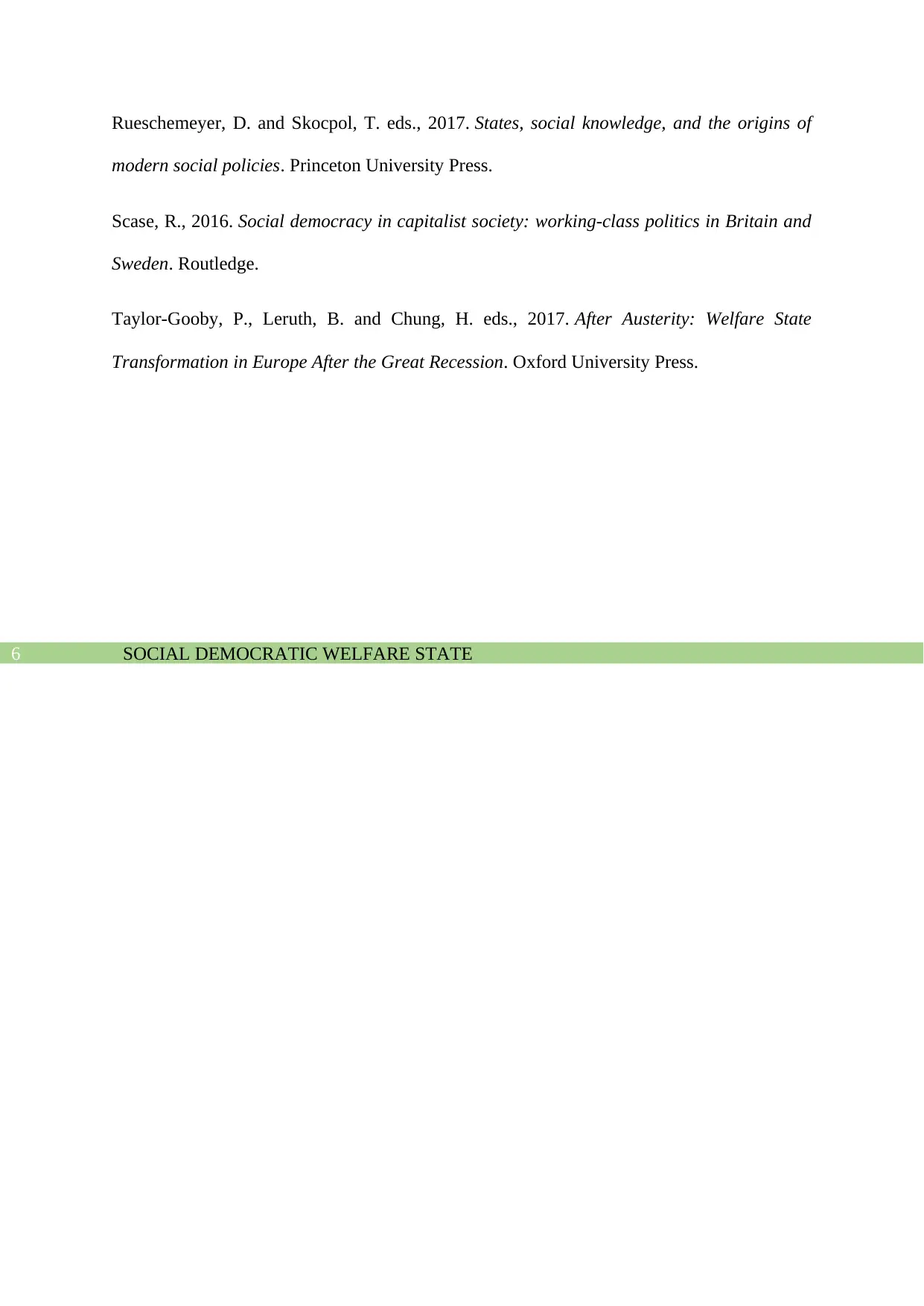
SOCIAL DEMOCRATIC WELFARE STATE6
Rueschemeyer, D. and Skocpol, T. eds., 2017. States, social knowledge, and the origins of
modern social policies. Princeton University Press.
Scase, R., 2016. Social democracy in capitalist society: working-class politics in Britain and
Sweden. Routledge.
Taylor-Gooby, P., Leruth, B. and Chung, H. eds., 2017. After Austerity: Welfare State
Transformation in Europe After the Great Recession. Oxford University Press.
Rueschemeyer, D. and Skocpol, T. eds., 2017. States, social knowledge, and the origins of
modern social policies. Princeton University Press.
Scase, R., 2016. Social democracy in capitalist society: working-class politics in Britain and
Sweden. Routledge.
Taylor-Gooby, P., Leruth, B. and Chung, H. eds., 2017. After Austerity: Welfare State
Transformation in Europe After the Great Recession. Oxford University Press.
1 out of 7
Related Documents
Your All-in-One AI-Powered Toolkit for Academic Success.
+13062052269
info@desklib.com
Available 24*7 on WhatsApp / Email
![[object Object]](/_next/static/media/star-bottom.7253800d.svg)
Unlock your academic potential
© 2024 | Zucol Services PVT LTD | All rights reserved.


